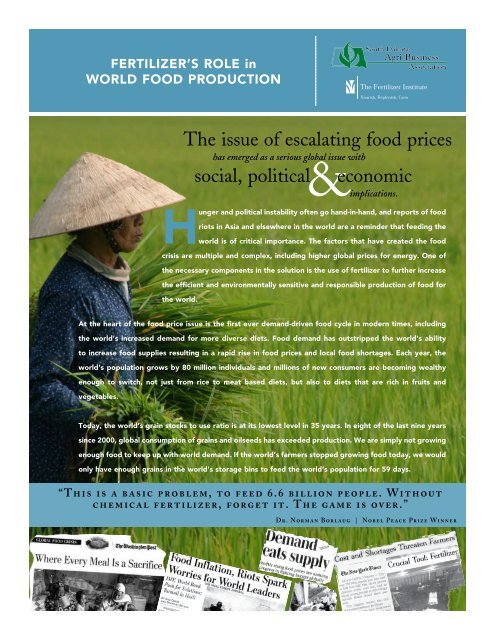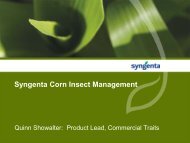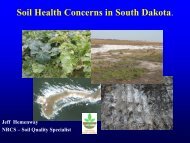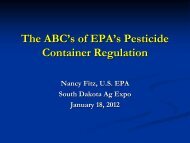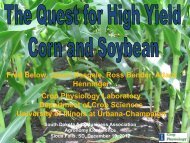Fertilizer's Role in World Food Production - South Dakota Agri ...
Fertilizer's Role in World Food Production - South Dakota Agri ...
Fertilizer's Role in World Food Production - South Dakota Agri ...
Create successful ePaper yourself
Turn your PDF publications into a flip-book with our unique Google optimized e-Paper software.
fertilizer’s role <strong>in</strong><br />
WORLD FOOD PRODUCTION<br />
The Fertilizer Institute<br />
Nourish, Replenish, Grow<br />
The issue of escalat<strong>in</strong>g food prices<br />
has emerged as a serious global issue with<br />
social, political<br />
&<br />
economic<br />
implications.<br />
Hunger and political <strong>in</strong>stability often go hand-<strong>in</strong>-hand, and reports of food<br />
riots <strong>in</strong> Asia and elsewhere <strong>in</strong> the world are a rem<strong>in</strong>der that feed<strong>in</strong>g the<br />
world is of critical importance. The factors that have created the food<br />
crisis are multiple and complex, <strong>in</strong>clud<strong>in</strong>g higher global prices for energy. One of<br />
the necessary components <strong>in</strong> the solution is the use of fertilizer to further <strong>in</strong>crease<br />
the efficient and environmentally sensitive and responsible production of food for<br />
the world.<br />
At the heart of the food price issue is the first ever demand-driven food cycle <strong>in</strong> modern times, <strong>in</strong>clud<strong>in</strong>g<br />
the world’s <strong>in</strong>creased demand for more diverse diets. <strong>Food</strong> demand has outstripped the world's ability<br />
to <strong>in</strong>crease food supplies result<strong>in</strong>g <strong>in</strong> a rapid rise <strong>in</strong> food prices and local food shortages. Each year, the<br />
world's population grows by 80 million <strong>in</strong>dividuals and millions of new consumers are becom<strong>in</strong>g wealthy<br />
enough to switch, not just from rice to meat based diets, but also to diets that are rich <strong>in</strong> fruits and<br />
vegetables.<br />
Today, the world’s gra<strong>in</strong> stocks to use ratio is at its lowest level <strong>in</strong> 35 years. In eight of the last n<strong>in</strong>e years<br />
s<strong>in</strong>ce 2000, global consumption of gra<strong>in</strong>s and oilseeds has exceeded production. We are simply not grow<strong>in</strong>g<br />
enough food to keep up with world demand. If the world’s farmers stopped grow<strong>in</strong>g food today, we would<br />
only have enough gra<strong>in</strong>s <strong>in</strong> the world’s storage b<strong>in</strong>s to feed the world’s population for 59 days.<br />
“This is a basic problem, to feed 6.6 billion people. Without<br />
chemical fertilizer, forget it. The game is over.”<br />
Dr. Norman Borlaug | Nobel Peace Prize W<strong>in</strong>ner
Fertilizer is a precious resource,<br />
which plays a critical role <strong>in</strong> world food production<br />
&<br />
is a<br />
necessary part of solv<strong>in</strong>g today's global food crisis.<br />
Just to keep up with food demand, we need record global crop production every year.<br />
Fertilizers are currently responsible for between<br />
40 and 60 percent of the world’s food supply.<br />
<strong>Fertilizer's</strong> major nutrients – nitrogen, phosphorus and<br />
potassium – are elements that occur naturally <strong>in</strong> the<br />
environment. Fertilizers replenish our soils <strong>in</strong> harvest<br />
after harvest to promote healthy and abundant crops<br />
for food production. Those nutrients are removed with<br />
the harvested crop and help provide nutritional value<br />
to the foods we eat. These nutrients must be replaced<br />
to ensure each year’s crop grows a nutritious supply of<br />
food.<br />
The United Nations <strong>Food</strong> and <strong>Agri</strong>culture Organization<br />
(FAO) estimates that the total world demand for<br />
agricultural products will be 60 percent higher <strong>in</strong><br />
2030 than it is today. FAO projects that more than<br />
85 percent of this additional demand will come from<br />
develop<strong>in</strong>g countries.<br />
The world’s options for <strong>in</strong>creas<strong>in</strong>g food production<br />
are limited both by the supply of land and water.<br />
Either we must place more of the world’s land under<br />
cultivation, <strong>in</strong>crease yields on exist<strong>in</strong>g acres, or both.<br />
Accord<strong>in</strong>g to the United Nations, there were over<br />
3.5 billion acres of arable land worldwide <strong>in</strong> 2005.<br />
Increas<strong>in</strong>g world population, among other factors,<br />
limits any significant expansion of global arable acres.<br />
While expansion of acreage is expected to <strong>in</strong>crease <strong>in</strong><br />
<strong>South</strong> American countries like Brazil and Argent<strong>in</strong>a,<br />
arable land is shr<strong>in</strong>k<strong>in</strong>g elsewhere. For example, Ch<strong>in</strong>a<br />
alone lost over 100,000 acres of arable land <strong>in</strong> 2007 and<br />
over a million acres of U.S. agricultural land are lost to<br />
development uses each year.<br />
For over half a century, the world has relied on<br />
<strong>in</strong>creas<strong>in</strong>g crop yields to supply an ever <strong>in</strong>creas<strong>in</strong>g<br />
demand for food. Accord<strong>in</strong>g to U.S. Department of<br />
<strong>Agri</strong>culture data, total world gra<strong>in</strong> production (corn,<br />
oats, barley, sorghum, wheat and rice) rose from 0.905<br />
billion metric tons <strong>in</strong> 1965 to 2.091 billion metric tons<br />
<strong>in</strong> 2007.<br />
Meanwhile, total harvested area of world gra<strong>in</strong>s, which<br />
accounts for nearly half of all arable land, is up only 4.3<br />
percent from its 1965 level and down 6.8 percent from<br />
the peak of 1.814 billion acres <strong>in</strong> 1981. This dramatic<br />
<strong>in</strong>crease <strong>in</strong> world gra<strong>in</strong> production was the result of a<br />
122 percent <strong>in</strong>crease <strong>in</strong> crop yields.<br />
In order to <strong>in</strong>crease world food production <strong>in</strong> a<br />
susta<strong>in</strong>able manner, farmers will need to use the right<br />
fertilizer at the right rate, right time and right place.<br />
We are faced with the first demand-driven food cycle <strong>in</strong> modern times.<br />
Changes <strong>in</strong> Total <strong>Food</strong> Consumption<br />
Strong Economic Growth:<br />
Average Real GDP Growth Rates<br />
kcal/person/year<br />
Percent<br />
3500<br />
3000<br />
2500<br />
2000<br />
1964/66<br />
1974/76<br />
1984/86<br />
2030<br />
2015<br />
1997/99<br />
12<br />
10<br />
8<br />
6<br />
1975-90<br />
1990-2000<br />
2000-07<br />
1500<br />
1000<br />
4<br />
500<br />
2<br />
0<br />
Sub-Saharan<br />
Africa<br />
Near East/<br />
North Africa<br />
<strong>South</strong> Asia<br />
East Asia<br />
0<br />
<strong>World</strong><br />
Developed<br />
Develop<strong>in</strong>g<br />
Ch<strong>in</strong>a<br />
India<br />
USA<br />
Source: United Nations <strong>Food</strong> and <strong>Agri</strong>culture Organization<br />
Source: U.S. Department of <strong>Agri</strong>culture
The nutrients from fertilizers are necessary for<br />
crop growth<br />
&<br />
an adequate fertilizer supply is an <strong>in</strong>tegral part of every<br />
nation’s food security.<br />
Fertilizer is a Strategic Commodity<br />
Each bushel of corn, wheat and soybeans needs the nutrients provided by commercial fertilizers.<br />
These nutrients are also necessary for meat production. <strong>Production</strong> of a pound of beef requires<br />
7 pounds of feed and every pound of pork produced requires 4 pounds of feed.<br />
Fertilizers are natural resource-based products. Nitrogen fertilizer is produced by captur<strong>in</strong>g<br />
nitrogen from the air us<strong>in</strong>g a complex chemical reaction. Nitrogen is currently produced <strong>in</strong> over<br />
80 countries worldwide. The primary raw material for nitrogen production is natural gas, but<br />
nitrogen can also be produced from coal, fuel oil and naphtha.<br />
The production of phosphate and potash fertilizers beg<strong>in</strong>s at the m<strong>in</strong>e. The manufacture of<br />
phosphate requires phosphate rock and sulfur. Phosphate rock reserves have been identified <strong>in</strong><br />
32 countries worldwide, but the economic extraction of the rock is limited to fewer countries,<br />
as the top three produc<strong>in</strong>g countries account for 63 percent of total world production while the<br />
top 12 account for 93 percent.<br />
Nitrogen (N)<br />
is a primary build<strong>in</strong>g block for all<br />
organisms. It is essential to mak<strong>in</strong>g<br />
prote<strong>in</strong>s, helps keep plants green<br />
and is a critical component of soil<br />
structure.<br />
comes from the air<br />
Potash ore reserves have been identified <strong>in</strong> 21 countries worldwide. Currently, the economic<br />
extraction of potash is limited to only 12 countries. Consequently, most countries have to rely<br />
on imports to meet demand. Potash is imported by more than 100 countries worldwide as over<br />
80 percent of world potash production is exported.<br />
The United States is the largest importer of fertilizer <strong>in</strong> the world, with more than half our<br />
nitrogen and nearly 90 percent of our potash supplies com<strong>in</strong>g from <strong>in</strong>ternational sources.<br />
Feed<strong>in</strong>g the <strong>World</strong> Requires New Research<br />
The world has experienced a 30 year “drought” of under<strong>in</strong>vestment <strong>in</strong> agriculture. If the world’s<br />
farmers are to reach their full potential, public and privately funded research must focus on<br />
improv<strong>in</strong>g crop yields through <strong>in</strong>creased fertilizer nutrient use efficiency. Through its support of<br />
the International Plant Nutrition Institute (IPNI), the fertilizer <strong>in</strong>dustry is currently support<strong>in</strong>g<br />
over 130 research projects worldwide that cont<strong>in</strong>ue to feed new scientific <strong>in</strong>formation <strong>in</strong>to<br />
cropp<strong>in</strong>g systems to better enable those systems to use the right fertilizer nutrients applied at the<br />
right rate, right time and right place and susta<strong>in</strong>ably <strong>in</strong>crease crop yields and food quality.<br />
phosphorus (p)<br />
is found <strong>in</strong> every liv<strong>in</strong>g cell. Phosphorus<br />
is a component of DNA and it also<br />
plays vital roles <strong>in</strong> captur<strong>in</strong>g light<br />
dur<strong>in</strong>g photosynthesis, help<strong>in</strong>g with<br />
seed germ<strong>in</strong>ation, and help<strong>in</strong>g plants<br />
use water efficiently. Plants also use<br />
phosphorus to help fight external stress<br />
and prevent disease.<br />
comes from ancient sea life<br />
The <strong>in</strong>dustry rema<strong>in</strong>s committed to m<strong>in</strong>imiz<strong>in</strong>g agriculture's environmental footpr<strong>in</strong>t. The<br />
use of best management practices such as the application of the right product at the right rate,<br />
right time and right place is a crucial part of this effort. However, these strategies will only be<br />
effective <strong>in</strong> meet<strong>in</strong>g the <strong>in</strong>tensify<strong>in</strong>g challenge of <strong>in</strong>creased world food demand if there is a<br />
recapitalization of production-oriented agriculture research <strong>in</strong>itiatives.<br />
Feed<strong>in</strong>g the <strong>World</strong> Requires Free Markets<br />
The recent food crisis has led some governments to engage <strong>in</strong> trade distort<strong>in</strong>g practices that<br />
have exacerbated the current food crisis. Government bans on exports of rice from Ch<strong>in</strong>a,<br />
India, Cambodia and Egypt are fuel<strong>in</strong>g food riots and disrupt<strong>in</strong>g global food trade patterns.<br />
potassium (k)<br />
is essential to the work<strong>in</strong>gs of every liv<strong>in</strong>g<br />
cell. It plays an important role <strong>in</strong> plants'<br />
water utilization and also helps regulate<br />
the rate of photosynthesis. Other aspects<br />
of plant health <strong>in</strong>fluenced by potassium<br />
<strong>in</strong>clude the growth of strong stalks,<br />
protection from extreme temperatures,<br />
and the ability to fight stress and pests<br />
such as weeds and <strong>in</strong>sects.<br />
comes from evaporated oceans<br />
Additionally, actions such as the implementation of Ch<strong>in</strong>a’s high export tax on fertilizers, which ranges from 100 to 135<br />
percent and is designed to keep fertilizer <strong>in</strong> the country for domestic use, create additional challenges to the world’s food<br />
production system.<br />
The fertilizer <strong>in</strong>dustry is partner<strong>in</strong>g with stakeholders to help farmers overcome local social and economic challenges and<br />
implement science-based best management practices. Unencumbered by artificial trade barriers, the world’s farmers will<br />
step up to today’s most critical challenge and produce an abundant supply of food for the world primarily through the<br />
appropriate application of chemical fertilizers.
1<br />
2<br />
3<br />
4<br />
What are the top five fertilizer nutrient<br />
consum<strong>in</strong>g countries <strong>in</strong> the world?<br />
Ch<strong>in</strong>a, India, the United States, Brazil and Pakistan,<br />
respectively.<br />
What are the top five fertilizer nutrient<br />
import<strong>in</strong>g countries <strong>in</strong> the world?<br />
The United States, Ch<strong>in</strong>a, Brazil, India and France,<br />
respectively.<br />
What are the top five fertilizer nutrient<br />
produc<strong>in</strong>g countries <strong>in</strong> the world?<br />
Ch<strong>in</strong>a, the United States, Russia, Canada, and India,<br />
respectively.<br />
What are the top five fertilizer nutrient<br />
export<strong>in</strong>g countries <strong>in</strong> the world?<br />
Russia, Canada, the United States, Belarus, and Germany,<br />
respectively.<br />
6<br />
7<br />
8<br />
Can fertilizer help African<br />
agriculture?<br />
Fertilizer use <strong>in</strong> Sub Saharan Africa is the world’s lowest,<br />
at less than 8 kg per hectare. As stated by the International<br />
Fertilizer Development Center, “No country has been able<br />
to expand agricultural growth rates and elim<strong>in</strong>ate hunger<br />
without <strong>in</strong>creas<strong>in</strong>g fertilizer use.”<br />
What about U.S. consumption of<br />
fertilizers?<br />
U.S. Department of <strong>Agri</strong>culture data shows that farmers<br />
today are us<strong>in</strong>g fertilizer nutrients with the greatest<br />
efficiency <strong>in</strong> history. Between 1980 and 2005, U.S. corn<br />
production <strong>in</strong>creased by 74 percent. In the same timeframe,<br />
farmers’ adoption of best fertilization practices, <strong>in</strong>clud<strong>in</strong>g<br />
placement near roots and tim<strong>in</strong>g of application, improved<br />
consumption efficiency. Use of nitrogen on corn <strong>in</strong>creased<br />
by only 3 percent while use of phosphate and potash<br />
fertilizers fell by 20 and 24 percent, respectively.<br />
How much has the ris<strong>in</strong>g price of<br />
fertilizer impacted the cost of food <strong>in</strong><br />
the United States?<br />
Despite dramatically ris<strong>in</strong>g prices, the cost of fertilizers still<br />
only represents a fraction of the cost of produc<strong>in</strong>g food.<br />
Fertilizer is only 2 percent of the cost of produc<strong>in</strong>g a loaf<br />
of bread and is 3 percent or less of the consumer price for<br />
chicken, beef and pork.<br />
5<br />
Which Countries are the <strong>World</strong>’s Top<br />
<strong>Food</strong> Producers?<br />
The United States leads the world <strong>in</strong> corn and soybean<br />
production and Ch<strong>in</strong>a leads the world <strong>in</strong> wheat and rice<br />
production.<br />
9Did you know?<br />
Accord<strong>in</strong>g to a recently released report published by<br />
the <strong>World</strong> Bank, global food prices <strong>in</strong>creased by 83<br />
percent between February of 2005 and February of 2008.<br />
•<br />
• More than one-half of the fertilizer used <strong>in</strong> Ch<strong>in</strong>a is used<br />
to grow fruits and vegetables.<br />
320 E Capitol Avenue | Pierre, SD 57501 | TEL (605) 224-2445 | FAX (605) 224-9913 | www.sdaba.org<br />
The <strong>South</strong> <strong>Dakota</strong> <strong>Agri</strong>-Bus<strong>in</strong>ess Association is an organization of crop <strong>in</strong>put professionals that promotes safe<br />
and economical crop production.<br />
820 First Street, N.E., Suite 430 | Wash<strong>in</strong>gton, D.C. 20002 | TEL (202) 962-0490 | FAX (202) 962-0577 | www.tfi.org<br />
The Fertilizer Institute<br />
Nourish, Replenish, Grow<br />
TFI serves to promote and protect the fertilizer <strong>in</strong>dustry, represent<strong>in</strong>g the public policy, communication and<br />
statistical needs of producers, importers, wholesalers and retailers of fertilizer, as well as those companies<br />
that provide vital services to the fertilizer <strong>in</strong>dustry.


